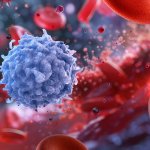Researchers have found that a drug designed to release stem cells into the bloodstream may actually treat some forms of lung injury.
The drug, called Plerixafor, is used around the world to fight some types of cancer but a new study suggests it may also protect against lung injuries caused by cigarette smoke.
What is Plerixafor and how does it work?
Plerixafor is a medication that encourages the immune system to release haematopoietic stem cells from the bone marrow into the blood stream.
It is used to treat some types of cancer that originate in blood cells, including multiple myeloma and non-Hodgkin lymphoma.
What are haematopoietic stem cells?
Haematopoietic stem cells (HPCs) are a type of undifferentiated stem cell that can develop into various other types of cell in the body.
They are key to the future of regenerative medicine and have the power to repair, replace and restore damaged or diseased tissue.
Research has shown that a lower count of HPCs in the bloodstream correlates to increased symptoms of emphysema, a form of chronic obstructive pulmonary disease. HPC count is diminished by exposure to cigarette smoke.1
Chronic obstructive pulmonary disease (COPD)
A lung disease that causes sufferers to increasingly struggle with breathing
The study
Researchers explored Plerixafor’s effect on stem cell circulation and lung function in two groups of mice.
The first group of mice were exposed to cigarette smoke five days a week for 22 weeks. The animals received regular injections of Plerixafor.
The second group was exposed to the same amount of smoke without receiving treatment.
The results
- The first group had no noticeable HPC depletion and after two weeks of treatment, HPC count increased.
- The second group suffered a noticeable drop in number of stem cells soon after they were exposed to cigarette smoke.
- The second group suffered from increased inflammation and changes in white blood cell count within lung fluid. These factors remained the same in the group treated with stem cells.
The impact
The study, published in the American Journal of Physiology–Lung Cellular and Molecular Physiology, suggests that doctors may be able to reverse or reduce the effects of cigarette smoke on the lungs in future.
For this particular experiment, stem cells were taken from bone marrow to treat the mice. However, two of the richest sources of HPCs are umbilical cord blood and tissue.
References:
Request a Welcome Pack
Find out more about cord blood banking by downloading a Welcome Pack now.









